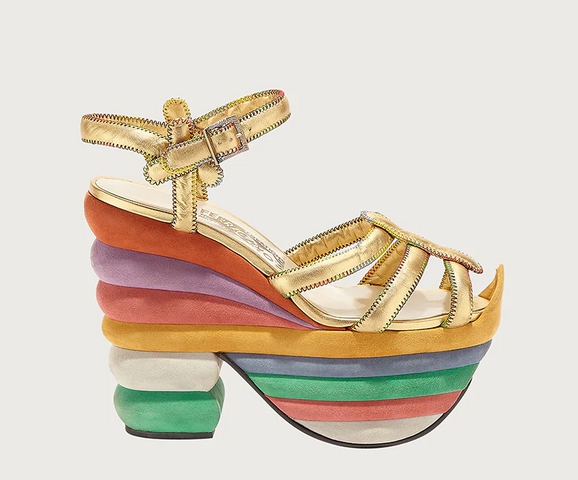Harajuku lovers is the name of the designer brand launched in 2005 by pop Singer Gwen Stefani. The brand produces a variety of merchandise, ranging from cosmetics to stationery, mobile phone charms and undergarments aiming at a demographic on tighter budgets. Stefani herself calls it a “glorified merchandise line”.
The concept of Harajuku Lovers revolves around the Harajuku area of the Shibuya district of Tokyo as well as the “Harajuku Girls” themselves, that is Stefani’s four backup dancers and entourage. They go by the stage names of Love, Angel, Music and Baby and their clothing is heavily influenced by Japanese streetwear.
Aiming for the skies: The Platform Shoe
The concept of making an impression by wearing extremely high heels and soles is an old one in both East and West. Ancient Greek tragic actors would wear kothorni (κόθορνος=the high heeled stage shoe) in order to give themselves the appearance of gods and demigods, a practice also followed by men of ancient China and their colleagues in today’s Peking opera. And it wasn’t just men. Geishas would wear Okobos

during their apprenticeship in medieval Japan, while platform undershoes called Pattens would be worn by high born courtesans and prostitutes to protect their shoes from the muddy streets of London and, of course, make them stand out from the competition.
A shoe over the rainbow
In the early 1930s Moshe (Morris) Kimel, a shoemaker of Jewish origin who managed to escape Berlin and start a business in Los Angeles designed a platform shoe for Marlene Dietrich that became very popular in Beverly Hills. By 1939, famous Italian designer Salvatore Ferragamo would carry on in Kimel’s footsteps. The Rainbow Shoe,

made exclusively for American singer, actress and vaudevillian Judy Garland, was the first truly notable instance of the platform shoe in the modern era. War shortages in leather forced Ferragamo to experiment with cork, a material still seen in platform shoes to this day. The result was an elevated but relatively light and comfortable shoe with much appeal. However, Ferragamo’s wartime ‘Rainbow Shoes’ were just a small taste of what was to come in the 60s and 70s, where the concept literally reached new heights.
Rebel, rebel
From young girls in their teens and twenties, to older women, to men wishing to attract some attention on the dancefloor, the platform shoe became the official “party shoe” of the 70s disco era. The transition owes a great deal to punk and glam rock artists such as the New York Dolls and David Bowie who would perform as his alter ego Ziggy Stardust, famously wearing a pair of glittering platform shoes.

The artist’s involvement in establishing the fad was quite in synch with Bowie being an icon of androgynous fashion. The elevated shoe was revolutionary and outrageous both in its design as in it didn’t really fit any gender norm. It was, simply put, “over the top”.
Spice up your height
By the end of the 80’s the appeal of the platform shoe had hit an all-time low, but it was always meant to aim for the skies. Legendary British fashion designer Vivienne Westwood would be the next to carry the torch, creating the Super Elevated Ghillies that would make supermodel Naomi Campbell trip on the catwalk of a fashion show. The platform shoe may have had a slippery start in the early 90s, but it would triumph yet again by the end of the decade, aided by the UK group “The Spice Girls” who would appear in Buffalo platform shoes and sneakers. The Girl Powered band shot their MTV videos and gave concerts several inches above ground, reminding the world that the platform shoe is indeed a British thing.

Platform shoes have since then had other resurgences, with the latest example being the 2010s mule sandal frenzy. Either born out of the stage requirements of Ancient Theatre, the “do’s” of the dancefloor, the eccentricities of the artists that fill the UK and USA charts or the even crazier trends that define Japanese street fashion, the tall shoe has many stories to tell, none of them being a tall tale.
The platforms of these Harajuku Lovers shoes have a thick plating of plaited straw matched with check patterned laces and toe caps of white and red. Platform shoes are an important accessory in Japanese “Canguro” street fashion and are oftimes matched with brightly coloured outfits, mini-skirts and colorful sarongs. Canguro fashion enthusiasts are often seen with bleached hair, fake eyelashes and a deep tan.

